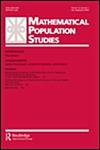World population densities: convergence, stability, or divergence?
IF 1.3
3区 社会学
Q3 DEMOGRAPHY
引用次数: 4
Abstract
ABSTRACT Taylor’s law states that the variance of population density in a given set of areas is a power function of its mean. When the exponent is equal to 2, the distribution of population densities between areas remains unchanged; when it is less than 2, the distribution converges toward the uniform distribution; when it is greater than 2, the densities become increasingly different from each other over time. The exponent takes the value 2 for East Asia, the Pacific, and South Asia. It takes a value greater than 2 for sub-Saharan Africa because the ongoing demographic transition and intense urbanization are redistributing the population over the territories. The exponent is lower than 2 for the other regions of the world, which have completed their demographic transition and where the rural exodus has been completed.世界人口密度:趋同、稳定还是分化?
摘要泰勒定律指出,给定区域内人口密度的方差是其均值的幂函数。当指数等于2时,地区之间的人口密度分布保持不变;当它小于2时,分布向均匀分布收敛;当它大于2时,密度随着时间的推移变得越来越不同。东亚、太平洋和南亚的指数取值为2。撒哈拉以南非洲的这一数值大于2,因为正在进行的人口转型和激烈的城市化正在将人口重新分配到各个地区。世界其他地区的指数低于2,这些地区已经完成了人口结构转型,农村人口外流也已经完成。
本文章由计算机程序翻译,如有差异,请以英文原文为准。
求助全文
约1分钟内获得全文
求助全文
来源期刊

Mathematical Population Studies
数学-数学跨学科应用
CiteScore
3.20
自引率
11.10%
发文量
7
审稿时长
>12 weeks
期刊介绍:
Mathematical Population Studies publishes carefully selected research papers in the mathematical and statistical study of populations. The journal is strongly interdisciplinary and invites contributions by mathematicians, demographers, (bio)statisticians, sociologists, economists, biologists, epidemiologists, actuaries, geographers, and others who are interested in the mathematical formulation of population-related questions.
The scope covers both theoretical and empirical work. Manuscripts should be sent to Manuscript central for review. The editor-in-chief has final say on the suitability for publication.
 求助内容:
求助内容: 应助结果提醒方式:
应助结果提醒方式:


